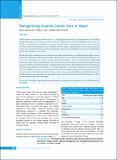Please use this identifier to cite or link to this item:
https://hdl.handle.net/20.500.14356/1136Full metadata record
| DC Field | Value | Language |
|---|---|---|
| dc.contributor.author | Paudel, Bishnu Dutta | - |
| dc.contributor.author | Love, Richard | - |
| dc.contributor.author | Shrestha, Deepak Sundar | - |
| dc.date.accessioned | 2023-04-27T07:51:54Z | - |
| dc.date.available | 2023-04-27T07:51:54Z | - |
| dc.date.issued | 2021 | - |
| dc.identifier.citation | PaudelB. D., LoveR., & ShresthaD. S. (2021). Reorganizing Hospital Cancer Care In Nepal . Journal of Nepal Health Research Council, 19(03), 442-449. https://doi.org/10.33314/jnhrc.v19i3.3761 | en_US |
| dc.identifier.issn | Print ISSN: 1727-5482; Online ISSN: 1999-6217 | - |
| dc.identifier.uri | http://103.69.126.140:8080/handle/20.500.14356/1136 | - |
| dc.description | Review Article | en_US |
| dc.description.abstract | Abstract While mortality rates for major common cancers— of the lung, breast, stomach, ovary, and lymphomas-- have declined significantly in high-income countries over the last decade, comparable rates for these malignancies have not fallen in Nepal. The explanations for the high-income country mortality trends are multiple and certainly include incidence reductions, but better treatments are also contributory. How to bring to Nepal the global lessons in achieving better cancer care is uncertain. We need to create an environment of ideas and a powerful vision to meet the needs for better major cancer management for Nepalis. Broadly, the Nepalese challenges are in creating more accessible and affordable care of sufficiently high-quality to make a difference. Hospitals are the major places where these issues have to be considered. To address these challenges, we offer a vision and suggest here strategies of major organizational changes in: Innovative staffing models, emphasizing teamwork, with increases in responsibilities, activities and work force percentages of non-physician health professionals; Increased outpatient care and tele-health; 3.Creating and following evidence-based diagnostic pathway and treatment clinical practice guidelines and checklists; 4. Increased application of information technology tools, particularly electronic medical records; and 5. Service implementation research evaluating quality based on structure, process and outcomes of care. Developing such effective changes requires strong community linkages, local institutional-specific coalition initiatives and experimentation, and national and international collaborations and financial support to effect practical and data-based plans and budgets. Keywords: Guidelines; improving treatment; information technology tools; outpatient services; staffing models; tele-health | en_US |
| dc.language.iso | en | en_US |
| dc.publisher | Nepal Health Research Council | en_US |
| dc.relation.ispartofseries | July-Sep, 2021;3761 | - |
| dc.subject | Guidelines | en_US |
| dc.subject | improving treatment | en_US |
| dc.subject | information technology tools | en_US |
| dc.subject | outpatient services | en_US |
| dc.subject | staffing models | en_US |
| dc.subject | tele-health | en_US |
| dc.title | Reorganizing Hospital Cancer Care In Nepal | en_US |
| dc.type | Journal Article | en_US |
| local.journal.category | Review Article | - |
| Appears in Collections: | Vol. 19 No. 03 (2021): Vol 19 No 3 Issue 52 Jul-Sep 2021 | |
Files in This Item:
| File | Description | Size | Format | |
|---|---|---|---|---|
| 3761-Manuscript-25057-1-10-20211215.pdf | Fulltext Download | 244.51 kB | Adobe PDF |  View/Open |
Items in DSpace are protected by copyright, with all rights reserved, unless otherwise indicated.
